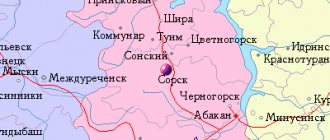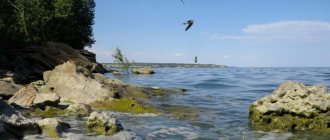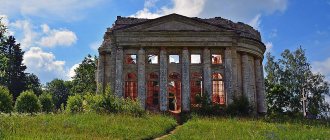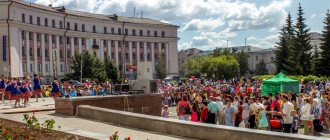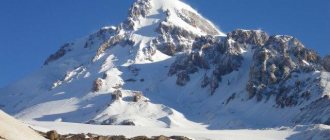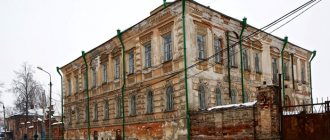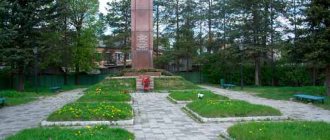Turan
(Tyva Republic)
OKATO code:
93235501
Founded:
1885
City since:
1945 City of district subordination (Piy-Khemsky district of the Republic of Tyva)
Center:
Piy-Khemsky district
Telephone code (reference phone)
| 39435***** | — |
Deviation from Moscow time, hours:
4
Geographic latitude:
52°09′
Geographic longitude:
93°55′
Altitude above sea level, meters:
860 Sunrise and sunset times in the city of Turan
Population
| Population | ||||||||
| 1959[4] | 1970[5] | 1979[6] | 1989[7] | 1998[8] | 2000[8] | 2001[8] | 2002[9] | 2006[8] |
| 5646 | ↘4539 | ↗5139 | ↗5976 | ↗6000 | ↘5700 | →5700 | ↘5598 | ↘5300 |
| 2007[8] | 2008[8] | 2009[10] | 2010[11] | 2011[12] | 2012[13] | 2013[14] | 2014[15] | 2015[16] |
| →5300 | →5300 | ↗5304 | ↘4981 | ↘4968 | ↘4911 | ↗4951 | ↘4873 | ↗4874 |
| 2016[17] | 2017[18] | 2018[19] | 2019[20] | 2020[21] | 2021[1] | |||
| ↗4898 | ↗4922 | ↘4879 | ↗4881 | ↗4903 | ↗4916 | |||
As of January 1, 2021, in terms of population, the city was in 1072nd place out of 1116[22]cities of the Russian Federation[23].
National composition
According to the 2002 census, of the 5,598 residents of the city, Russians made up 58.97% (3,301 people), Tuvans - 36.80% (2,060 people), Khakass - 0.70%, Armenians - 0.63%, Ukrainians - 0 .55%[24].
Map
| Turan: maps |
Turan: photo from space (Google Maps) Turan: photo from space (Microsoft Virtual Earth)
| Turan. Nearest cities. Distances in km. on the map (in brackets along roads) + direction. Using the hyperlink in the distance , you can get the route (information courtesy of the AutoTransInfo website) | |||
| 1 | Kyzyl | 59 (74) | SE |
| 2 | Kaa-Khem | 66 (89) | SE |
| 3 | Shagonar | 97 (180) | SW |
| 4 | Khovu-Aksy | 113 (175) | YU |
| 5 | Bay-Haak | 116 (152) | YU |
| 6 | Chaa-Khol | 129 () | SW |
| 7 | Saryg-Sep | 134 (158) | SE |
| 8 | Toora-Khem | 154 () | IN |
| 9 | Ermakovskoe (Krasnoyarsk region) | 161 (210) | NW |
| 10 | Karatuzskoe (Krasnoyarsk region) | 175 (394) | NW |
| 11 | Shushenskoye (Krasnoyarsk region) | 186 (254) | NW |
| 12 | Cheryomushki (Republic of Khakassia) | 186 (414) | NW |
| 13 | Samagaltai | 187 (236) | SE |
| 14 | Chadan | 188 (288) | SW |
a brief description of
Located in the Turan-Uyuk basin, on the river. Turan (left tributary of the Uyuk River, Yenisei basin), on the Usinsky tract (Abakan), 345 km from the railway. Abakan junction, 70 km northwest of Kyzyl.
Territory (sq. km): 94
Information about the city of Turan on the Russian Wikipedia website
Historical sketch
Founded in 1885 by Russian settlers from Siberia, who were engaged in ice farming, cattle breeding, hunting, and timber rafting.
The city of Turan since 1945. Turan is a Turkic word for “salt marsh, salt marsh meadow.”
Municipal indicators
| Index | 2001 |
| Demography | |
| Number of births, per 1000 population | 10.7 |
| Number of deaths, per 1000 population | 18.1 |
| Natural increase (decrease), per 1000 population | -7.4 |
| Standard of living of the population and social sphere | |
| Average monthly nominal accrued wages, rub. | 2270.7 |
| Average housing area per inhabitant (at the end of the year), sq.m. | 16.2 |
| Number of preschool institutions, pcs. | 3 |
| Number of children in preschool institutions, thousand people | 0.2 |
| Number of daytime educational institutions (at the beginning of the school year), pcs. | 2 |
| Number of students in daytime educational institutions, thousand people | 1.3 |
| Number of doctors, people. | 14 |
| Number of nursing staff, people. | 95 |
| Number of hospital institutions, pcs. | 1 |
| Number of hospital beds, thousand units | 0.1 |
| Number of medical outpatient clinics, pcs. | 1 |
| Capacity of medical outpatient clinics, visits per shift, thousand units. | 0.2 |
| Number of registered crimes, pcs. | 158 |
| Persons who committed crimes were identified, persons. | 13 |
| Economy, industry | |
| Number of enterprises and organizations (at the end of the year), pcs. | 62 |
| Construction | |
| Volume of work performed by type of activity “Construction” (until 2004 - volume of work performed under construction contracts), million rubles. | 14.9 |
| Commissioning of residential buildings, thousand sq.m. of total area | 0.1 |
| Commissioning of residential buildings, apartments | 3 |
| Commissioning of preschool institutions, places | 0 |
| Commissioning of educational institutions, places | 0 |
| Commissioning of hospital facilities, beds | 0 |
| Commissioning of outpatient clinics, visits per shift | 0 |
| Transport | |
| Number of bus routes (in intracity traffic), pcs. | 0 |
| Number of passengers transported by buses per year (in intracity traffic), million people. | 0 |
| Connection | |
| Number of residential telephone sets of the city public telephone network, thousand units. | 0.8 |
| Trade and services to the population | |
| Retail trade turnover (in actual prices), million rubles. | 62.1 |
| Retail trade turnover (in actual prices), per capita, rub. | 10843 |
| Public catering turnover (in actual prices), million rubles. | 0.5 |
| Volume of paid services to the population (in actual prices), million rubles. | 2.1 |
| Volume of paid services to the population (in actual prices), per capita, rub. | 369 |
| Volume of household services to the population (in actual prices), million rubles. | 0.6 |
| Volume of household services to the population (in actual prices), per capita, rub. | 112 |
| Investments | |
| Investments in fixed assets (in actual prices), million rubles. | 19.6 |
| Share of investments in fixed assets financed from budgetary funds in the total volume of investments, % | 98.1 |
Data sources:
- Regions of Russia. Main characteristics of the constituent entities of the Russian Federation: statistical collection. Goskomstat of Russia. - M:, 2003.
Economy
Industrial plant. Woodworking industry enterprises.
In the Piy-Khem region: meat and wool livestock farming, grain crops (wheat, oats, barley).
Museums, galleries, exhibition halls
Turan Museum of Local Lore 668510, Republic of Tyva, Piy-Khemsky district, Turan, st. Druzhby, 44
Architecture, sights
Turan is characterized by modern buildings. Wide and straight streets are lined with rows of larches.
| Population by year (thousands of inhabitants) | |||||||
| 1959 | 5.6 | 2001 | 5.7 | 2011 | 5.0 | 2018 | 4.9 |
| 1970 | 4.5 | 2003 | 5.6 | 2012 | 4.9 | 2019 | 4.9 |
| 1979 | 5.1 | 2005 | 5.4 | 2013 | 5.0 | 2020 | 4.9 |
| 1989 | 6.0 | 2006 | 5.3 | 2014 | 4.9 | 2021 | 4.9 |
| 1992 | 5.6 | 2007 | 5.3 | 2015 | 4.9 | ||
| 1998 | 6 | 2008 | 5.3 | 2016 | 4.9 | ||
| 2000 | 5.7 | 2010 | 5.3 | 2017 | 4.9 | ||
Tuva.Asia / New studies of Tuva
This year marks 130 years since the founding of Turan, the very first Russian village in Tuva.
In 1885, Minusinsk merchant and gold miner Georgy Pavlovich Safyanov received permission to engage in farming along the Turan River. Several Russian families from the village of Verkhne-Usinskoye, using this permission, plowed the land and built their first houses.
Within four years, seven householders lived here. Here is what the famous scientist Nikolai Fedorovich Katanov writes about Turan, who, on instructions from the Russian Geographical Society, visited the Uriankhai region in 1889: “We arrived at the Turan settlement at about 10 pm. We stopped with the Kaptyrevsky peasant Semyon Petrovich Gorbunov, who settled here with his entire large family. The Russians have arable land, houses, bathhouses and vegetable gardens here.
In the Turan village there live about 35 Minusinsk peasants with their wives and children. There are seven main householders: Nikolai Petrovich Byakov, Semyon Petrovich Gorbunov, Kirila Savovich Pospelov, Grigory Ivanovich (Ivoilovich) Funtikov, Timofey Leontievich Petukhov, Afanasy Zlotnikov and Mokei Kazantsev.
There are seven huts here. Byakov lives on the left bank of Turan, and the rest on the right. About 1/2 verst away there is a tall stone pillar with runic inscriptions and figurative images.
The peasants also fish, of which there is an awful lot here. Funtikov has deer on Turan.”
Fourteen years later, Turan had already become a fairly large village. The head of the Mongolian expedition of the General Staff, Captain Viktor Popov, who visited here in 1903, writes in the essay “Through the Sayans to Mongolia”: “The Turan village has been formed for more than twenty years, it consists of 55 households, has 300 inhabitants. The buildings are large, solid, even two-story houses are being built, each farm has good vegetable gardens, and around several miles there are well-cultivated fields strewn with heaps of harvested grain, clean meadows with large haystacks and vast pastures with large herds of livestock, all testifying to the significant prosperity of the inhabitants "
Over time, Turan not only grows numerically, but also becomes the first Russian cultural center of the Uriankhai region - the first cultural institutions appear here. So, in 1908, the first school in the Uriankhai region was built by the residents themselves, in 1910 the construction of an Orthodox church began, in 1913 a medical center and pharmacy were opened, in 1915 the first library began to function - a reading room and an amateur theater, in 1917 a post office was opened department and telegraph. There was also a zemstvo apartment in Turan - a hotel.
In the diary entries of Sergei Mintslov, a member of the Russian Geographical Society, sent to Tuva in 1914, it is written: “Turan is a very large village, stretched out in one line as is the custom of all Russian villages. It arose about twenty-five years ago without permission, and its inhabitants are prosperous: plow land as much as you want; a man who has two or three horses and four or five cows is considered poor; households of average prosperity number forty to fifty cows and ten to twenty horses.
Jingling our bells, we rushed along the wide street and turned into the courtyard of the zemstvo apartment. The main attraction of the village is the stone phallus, which now stands in front of the school windows, in the front garden. Previously, it was located in one of the peasant gardens in the south-eastern part of the village and was transported to its present location by order of Gabaev. A decayed skeleton of a mammoth was found in the ground next to him.
Turanian peasants often plow up all sorts of bronze and iron objects in their fields.
The resettlement department has set up a pharmacy and a hospital in the village, there is a doctor, a paramedic and a paramedic. It also built a school and a church, so far the only one in the whole of Uriankhai. Both the pharmacy and everything else made a favorable impression on us with their cleanliness and comfort.”
Mintslov’s book “Secret Assignment. Journey to Uriankhai" was recently republished thanks to the Russian Geographical Society and the Tuvan Institute of Humanitarian Research and is of great interest to both scientists and ordinary readers. Along with the diary of Sergei Mikhailovich Mintslov, a photo album of photographs taken by the Mintslov spouses during a trip to Uriankhai was published.
In the following decades, a post office was opened, another school building, a club, a new hospital building, a power plant were built, school No. 2, a road maintenance site DEU-977, a regional industrial complex, a branch of the state bank were opened, a collective farm was organized, and a radio appeared.
In 1937, by the decision of the Khoshun Khural, then supported by the decree of the Small Khural, Turan became a city with three streets: Toka, Sovetskaya, Druzhby.
After Tuva joined the Soviet Union in 1944, Turan began to grow and develop rapidly - in 1946, two new organizations appeared: forestry and MTS. Then repair and construction organizations appeared - RSU and PMK, which were engaged in the construction and repair of residential buildings in Turan and in the villages of the region. A state industrial enterprise with a maral farm was opened, and a logging site—LZU—was operating. Raipromkombinat, which had workshops for tanning leather and sewing shoes, distilling tar and burning lime, making bricks, added a workshop for wood processing and furniture manufacturing, a sewing workshop appeared, a hairdresser, workshops for repairing household appliances, and a dry cleaner were opened. In Turan there was a bath and laundry plant, a cinema, first a music school, and then an art school with several departments, a house of pioneers, a museum, a school for construction workers, librarianship developed, and several kindergartens were opened. The collective farm "Red Plowman" became a state farm with the same name. There was another organization - agricultural chemistry.
Turan himself trained specialists in various fields of knowledge for himself and regional villages. Thus, six-month courses for librarians were opened at the district library, the district hospital trained nurses, the school team trained future machine operators, DOSAAF trained drivers of all categories, and a school for construction masters - builders.
By the beginning of the nineties, Turan already had 44 streets, the landscaping of which was actively carried out since the mid-sixties, at the same time a modern two-story building was built for school No. 1, and unfortunately, the church of St. Innocent, the very first in Tuva. In those years there were few cars in Turan; you could often see a horse and cart in the summer or a sleigh in the winter. But all central streets were equipped with wooden sidewalks.
The nineties became fatal for Turan - much of what had been created through the efforts of previous years was destroyed. The only object that was built in those years was the new church of St. Innocent.
Now among the operating organizations are the federal postal service department, KUES, MUP "Teplovik", "Tuvaenergosbyt", three schools: Russian, Tuvan and "open", almost all kindergartens and a dairy farm have been preserved.
Federal reforms also hit regional centers hard. The forestry enterprise has become a forestry without foresters, and in order to obtain permission to collect firewood, you need to wait at least a month, because a simple certificate is issued not in Turan, but in Kyzyl, and consists of several sheets with texts that are never read by anyone: people need firewood, not piles of papers.
The district police has turned into a police station, and all important and unimportant matters are decided in Kyzyl, and for every little thing you have to go there.
The district hospital changed from a municipal one to a federal one, but this change did not make things better for patients, and compared to the end of the last century, it was much worse. If previously we had almost all the specialized specialists in our hospital - a cardiologist, an ENT specialist, an anesthesiologist and others, now we don’t have them, and if necessary, we have to go to the hospital, which is full of sufferers from all over the republic. There is not even a morgue, or rather there is one, but there is no forensic expert. The dead are also taken to Kyzyl, and there, they say, there is such a queue for this establishment that you won’t be able to finish it in one or two days. The former DRSU, a very large enterprise at one time, was bought by Vostok LLC and, it seems, turned into just a small site for the repair of the M-54 highway.
Of course, many new and interesting things have appeared: communications available to almost everyone, the Internet. A lot of cars. But this is rather a minus, because the streets in Turan are very unkempt, there are no sidewalks, you have to walk along the roadway. It is especially dangerous in the morning, in winter, when children walk to school along unlit streets. The streets are not cleared of snow, cars create big ruts - and this makes walking on them even more difficult and dangerous.
There are many shops, but the goods are the same everywhere, very primitive and expensive.
The pluses include the availability of building materials, thanks to which Turan began to transform - old houses are being refaced, additional square meters of living space are being built, fences are being improved, etc.
It is very good that new houses are being built for orphans. One four-story house has been built under the Dilapidated Housing program, and another temple is being built.
Taxis and private minibuses have appeared in Turan, which are very convenient for getting to the capital, because now all our, often even small, affairs are decided there. And if you really need to, you can drive through the city from end to end. This is especially convenient for older people.
But here’s what’s most alarming: Turan has not escaped the fate of most of the regional centers of Tuva; it has fewer and fewer inhabitants. If at the end of the eighties a little more than six thousand people lived in Turan, then already in 2005 the number of residents decreased to 5,250 people, and in 2015 it amounted to 4,874 people, including only 30 percent Russians. Some moved to Kyzyl, some - for the Sayans. Probably, this process is largely due to objective circumstances characteristic of the entire country. But …
Turan has exchanged another decade of its history. What will be new for my hometown?
Tatiana VERESCHAGINA, Tuvinskaya Pravda
Notes
- ↑ 12
The permanent population of the Russian Federation by municipalities as of January 1, 2021 (Russian). Date accessed: April 27, 2021. Archived May 2, 2021. - Federal Law of 06/03/2011 No. 107-FZ “On the calculation of time”, Article 5 (undefined)
(June 3, 2011). - Pospelov, 2008, p. 449.
- All-Union Population Census of 1959. The size of the urban population of the RSFSR, its territorial units, urban settlements and urban areas by gender (Russian). Demoscope Weekly. Access date: September 25, 2013. Archived April 28, 2013.
- All-Union Population Census of 1970 The size of the urban population of the RSFSR, its territorial units, urban settlements and urban areas by gender. (Russian). Demoscope Weekly. Access date: September 25, 2013. Archived April 28, 2013.
- All-Union Population Census of 1979 The size of the urban population of the RSFSR, its territorial units, urban settlements and urban areas by gender. (Russian). Demoscope Weekly. Access date: September 25, 2013. Archived April 28, 2013.
- All-Union population census of 1989. Urban population (undefined)
. Archived from the original on August 22, 2011. - ↑ 123456
People's encyclopedia "My City". Turan (city) - All-Russian population census 2002. Volume. 1, table 4. Population of Russia, federal districts, constituent entities of the Russian Federation, districts, urban settlements, rural settlements - regional centers and rural settlements with a population of 3 thousand or more (unspecified)
. Archived from the original on February 3, 2012. - The size of the permanent population of the Russian Federation by cities, urban settlements and regions as of January 1, 2009 (unspecified)
. Retrieved January 2, 2014. Archived January 2, 2014. - All-Russian population census 2010. 1.5. Population of urban districts, municipal districts, urban and rural settlements, urban settlements, rural settlements (undefined)
. Access date: December 31, 2021. - Tyva Republic. The total population by sex and age as of January 1 of the current year. 2008-2015
- Population of the Russian Federation by municipalities. Table 35. Estimated resident population as of January 1, 2012 (unspecified)
. Retrieved May 31, 2014. Archived May 31, 2014. - Population of the Russian Federation by municipalities as of January 1, 2013. - M.: Federal State Statistics Service Rosstat, 2013. - 528 p. (Table 33. Population of urban districts, municipal districts, urban and rural settlements, urban settlements, rural settlements) (undefined)
. Retrieved November 16, 2013. Archived November 16, 2013. - Table 33. Population of the Russian Federation by municipalities as of January 1, 2014 (unspecified)
. Access date: August 2, 2014. Archived August 2, 2014. - Population of the Russian Federation by municipalities as of January 1, 2015 (unspecified)
. Access date: August 6, 2015. Archived August 6, 2015. - Population of the Russian Federation by municipalities as of January 1, 2021 (Russian) (October 5, 2018). Date accessed: May 15, 2021. Archived May 8, 2021.
- Population of the Russian Federation by municipalities as of January 1, 2021 (Russian) (July 31, 2017). Retrieved July 31, 2021. Archived July 31, 2021.
- Population of the Russian Federation by municipalities as of January 1, 2021 (Russian). Retrieved July 25, 2018. Archived July 26, 2021.
- Population of the Russian Federation by municipalities as of January 1, 2021 (Russian). Date accessed: July 31, 2019. Archived May 2, 2021.
- Population of the Russian Federation by municipalities as of January 1, 2021 (Russian). Date accessed: October 17, 2021. Archived October 17, 2021.
- taking into account the cities of Crimea
- https://rosstat.gov.ru/storage/mediabank/bul_Chislen_nasel_MO-01-01-2021.rar Population of the Russian Federation by municipalities as of January 1, 2021 (1.85 Mb, 07/30/2021)
- Data from the 2002 All-Russian Population Census: table 34u-Tuva. M.: Federal State Statistics Service, 2004. (2002zip, see note)
History[edit]
The first church in Turan in honor of St. Innocent of Irkutsk was built in 1911 and operated until 1961, when it was closed by decision of local authorities. Now this church is part of a school building.
In 1995, a new temple was built and consecrated, also named in honor of St. Innocent.
In 2015, there was a need for a major overhaul of the temple building. During the consultations, they came to the conclusion that it would be better to erect a new stone church in the traditions of ancient Russian church architecture.
In commemoration of the Russian Orthodox Church's celebration of the 1000th anniversary of the repose of Equal-to-the-Apostles Prince Vladimir, it was decided to dedicate the future temple to this saint.
The building was erected according to the project of Tuvagrazhdanproekt OJSC using funds from patrons and voluntary donations from believers.
On July 28, Bishop Feofan of Kyzyl and Tuva performed the rite of great consecration of the Prince Vladimir Church in Turan, the construction of which had been underway since 2015. The entire clergy of the Kyzyl diocese took part in the celebration; parishioners of the churches of the city of Kyzyl and other parishes of the diocese came to share the joy with the residents of Turan. The honored guests were the Head of the Republic of Tyva Kara-ool Sh. V., members of the Government, deputies of the Supreme Khural, representatives of various departments and public organizations.
After the altar and altar were consecrated in the altar, the clergy and believers proceeded in procession to the church in honor of St. Innocent of Irkutsk, located on the territory of the parish, to transfer particles of the relics of the holy martyrs Hilarion of Vereisky and Alexander of Riga, which were then placed under the altar and in the antimension Prince Vladimir Church.
At the end of the ceremony of the great consecration of the temple, the Divine Liturgy began. On this day, hundreds of believers prayed, most of whom partook of the Body and Blood of Christ. The Divine Liturgy ended with a procession of the cross around the temple. After the dismissal, Bishop Theophan addressed a sermon to all those gathered, expressing gratitude to everyone who took part in the creation of the shrine. The church's patrons and builders received certificates of gratitude and memorial signs.
Construction took two years.
